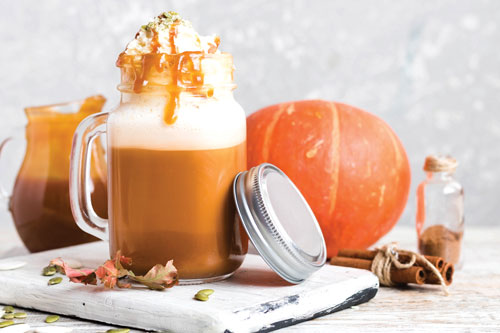Not-So-Pumpkin Spice

By Margo Graf
Now that we are in full swing of autumn, I am just going to come out and say it: Pumpkin Spice Lattes have no connection to pumpkins whatsoever. It’s true! The seasonal hype has been nothing more than a white lie–seduced by the sweet aromas of cinnamon, nutmeg, ginger, allspice, and cloves. That six-dollar coffee? Doesn’t have a drop of pumpkin.
So instead of waiting in line for an expensive Not-So-Pumpkin Spice Latte, you can save time, money, and a single-use cup by brewing a pot at home. Once you have had your caffeine fill and are ready to take on the world, head out to find a real pumpkin. The annual pumpkin industry reaches around 1 billion pumpkins grown per year. October, which is deemed pumpkin month, sees 800 million of that billion harvested. You should have no trouble securing one or two–or thirty.
By now, you have seen them all over Kernersville. From storefronts, garden centers, neighborhood porches…colorful, lumpy pumpkins have infiltrated every empty space. If you still have an open spot on your counter, it is not too late to plop a pumpkin on it. By searching “pumpkins in Kernersville” you will find local patches with good pickins’ available. Whether you want to make a fun family outing or just quickly go to a neighborhood pumpkin stand, here are some reasons why you need a real pumpkin over the latte-wanna-be.
Were you recently bitten by a snake? Or do you have too many freckles? Just add some pumpkin! Okay, actually, don’t do that. But this was once a believed use of the squash. Luckily, science progresses (and freckles are cute!).
Pumpkins (not lattes) do, however, contain several essential vitamins that our bodies need, especially as our natural intake from the sun decreases in the fall. Keep in mind it is recommended to add extra vitamins to your diet during the darker months, and seasonal veggies are a great way to do this. Even though pumpkins are 90 percent water, the meat is a good source of potassium and Vitamin A.
If you are able to catch any pumpkins still linked to their patch, pick off some of the flowers. You can eat them raw! Pumpkin flowers can also be added to salads, dipped in pancake batter and fried, or chopped and used as a garnish. Only eat the male flowers if you want the female flowers to grow the actual fruit. You can tell the sex by looking at the base of the flower. The male flowers will have a thin stem with no fruit growth while the females will start ballooning with the baby pumpkin.
One cup of pumpkin flowers has the following nutritional profile:
• 643 IU Vitamin A
• 9 mg Vitamin C
• 57 mg Potassium
• Plus other essential micronutrients
Beyond the meat and flowers, pumpkins are so versatile you can actually eat the entire plant. The seeds have more protein than peanuts. Carve them out, sprinkle with salt, and roast. The seeds also contain good fatty acids such as oleic acid and alpha-linolenic acid. This is a healthy, comfort snack meant for indulging. But don’t stop there; the leaves themselves are edible. The younger the leaves the better, as the older ones are a bit tough. Pick and sauté like you would any winter leafy green. It is the gourd that keeps on giving!
Of course, there are so many varieties of pumpkins, depending on which you pick, you can use for various dishes. From nutty to sweet, the flavor profile is what makes this squash applicable in a plethora of cuisines. Soups, pies, pancakes, lattes, you name it. Pumpkins are more than just a pretty accent piece, so make sure to enjoy them to the fullest.
As the great American essayist, poet, and philosopher Henry David Thoreau once said, “I would rather sit on a pumpkin and have it all to myself than be crowded on a velvet cushion [with a falsely named coffee].”
